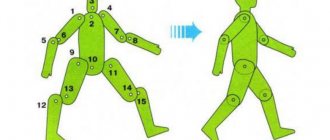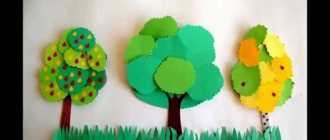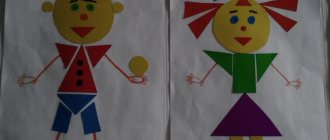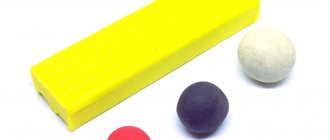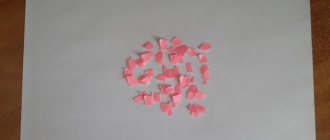Applique “Dress for Cinderella” senior group
Tasks:
teach children to use different applique techniques (symmetrical, overhead); compositionally position images correctly; use paper of different textures to create an expressive image;
develop a sense of form and composition, fine motor skills; be able to select harmoniously combined colors; cultivate accuracy in working with paper and glue, independence.
Preliminary work.
Examination of illustrations in children's books (“Cinderella” by C. Perrault); exhibition of festive children's clothing, a doll with a set of outfits.
Material:
colored and white soft paper, paper napkins of different colors, scissors, glue, glue brushes, cloth napkins, oilcloth, colored pencils to complement the application composition with graphic means.
Progress of the lesson:
The group organizes an exhibition of children's and doll's elegant clothes.
Educator.
Do you guys remember the fairy tale about Cinderella? What dress did Cinderella wear to work? Can she go to the ball in it? Why? Who helped Cinderella find a beautiful outfit? Did she have a choice in choosing an outfit? Where do you choose your outfits (in the store) What should poor Cinderella do, how to help (invite her to the store, help her choose). Come closer, let’s take a closer look. Look at the clothes. What is she like? (Dressy.) How is it different from casual? (fabric, color, decoration.) What is this dress decorated with? (Bows, lace.) Is it comfortable to work in such a dress? Clean the floor? (No, it’s long, white lace, satin bows.) Where can you go in such outfits? (For a matinee in kindergarten, at the theater, for a birthday, at a museum.)
Before the tailor sews an outfit, an artist will come up with and draw it. Such artists are called “fashion designers”, “designers”. They come up with new styles of clothes, making them comfortable and elegant. The profession of a fashion designer requires imagination, invention, and a developed sense of beauty. Do you want to become a fashion designer at least temporarily? (Answers.) Then let's first come up with and then make different outfits: suits, dresses, blouses. And then we will have a “Fancy Dress Shop” where Cinderella will come and choose an outfit for herself.
Finger gymnastics
- So that our hands can cope with the task, let's play with them.
I put on clothes Alternately connect the fingers with the right
hands with a big one.
And I call it for you: Alternately connect your fingers with your left
hands with a big one.
T-shirt, trousers, and also Alternately connect the fingers with the right
hands with a big one.
Sweater, scarf and coat. Alternately connect your fingers with your left
hands with a big one.
Let's start work.
Round one corner of the square using the “corner to corner” method. The result is a “skirt”. Glue the cut piece to the right corner of the “skirt”. Cut off the sharp corners, departing from the right angle by about 3 cm. The result is a dress.
Cut 3 cm from the edge of a paper napkin folded in four, so you get two identical long strips. Make a skirt from one, and sleeves from the other.
Apply a thin bead of glue to the bottom of the dress. From left to right, press the napkin to the hem with small folds. Glue the sleeves in the same way, after first cutting the second strip of napkin along the fold into two halves. Place the folds from top to bottom.
Decorate the waist with a bow by twisting a strip of paper napkin in the middle, like a candy wrapper.
At the end of the work, all outfits are placed on cardboard (store display) and examined.
RESULT: What is the most fashionable outfit? What is it decorated with? What dress would you choose for Cinderella to wear to the ball? What dress would you wear to the theater?
<…1. Introductory part. Organizational moment (2 min.). Children enter the hall. Greet guests. Teacher: - Guys, do you like to travel? (children's answers) - What can you go on a journey with? (children's answers) - Is it possible to walk? (children's answers) - I suggest you go to a magical, fairy-tale clearing... - Oh, guys, look: someone's footprints? Whose tracks do you think these are? Let's see where they take us? Children follow in the footsteps of the teacher. The children go into the hall, there they find a felt boot lying in a “snowdrift”. Teacher: - Here is our magical clearing. Oh, guys, look what it is here in the snowdrift? (children's answers) - Which of you guys have felt boots? Maybe some of you have lost it? (children's answers) - Then let's leave it here, suddenly the one who lost it will return (children's answers).- Main part.
Listening to K.I. Chukovsky’s poem “The Miracle Tree” (5–7 min.). - Guys, I already told you that a fairy tale awaits you here. So, this good fairy tale is the poem “The Miracle of a Tree,” and it was written by Korney Ivanovich Chukovsky (portrait of K. I. Chukovsky, slide 1). – Now, guys, sit down more comfortably, now we will listen to this poem performed by the author himself, Korney Ivanovich Chukovsky. Children sit on chairs and listen. (Slide 2, 3) - Guys, why was the tree in the fairy tale that we listened to called wonderful, a miracle - a tree? (slide 4) (children's answers) - Guys, you know that shoes are seasonal. Tell me, what is the name of the shoes we wear in the summer? (in one word) In autumn? In winter? (children's answers) - Guys, guess the riddle? Not shoes, not boots, But feet wear them too, We run in them in winter, In the morning - to kindergarten, in the afternoon - home! Children: Valenki (slide 5). Teacher: - Guys, Dasha knows a poem about felt boots, and now she’ll tell us about it. The child recites a poem. Teacher: - Guys, what do you know about felt boots? (children's answers) - Do you know how felt boots are made? Do you want me to tell you? (Children's answers) Show a presentation about felt boots, their properties, stages of production, decor options (3 min.). (slide 6) Valenki is a simple Russian word. From time immemorial they have been an integral part of Russian costume, Russian winter. The felt boots are rustic, but also durable, reliable, and will not let you down in difficult times! Valenki are comfortable and healing shoes. In felt boots we are not afraid of the most severe frosts. Felt boots are soft winter boots made of wool (slide 7). Felting a felt boot means rolling the wool into a certain shape - the shape of a felt boot. But felt boots are produced only in Russia, and the tradition of this craft is passed on from generation to generation. (slide Valenki are the only shoes made entirely from natural materials: wool is simply sheared from sheep and processed - felted. And felted like this: they treated the wool with boiling water, steam, smoke, knocked it into a total mass (slide 9) - felt - and rolled it - first on the table (slide 10), and then on a block of the required size... (slide 11) Felt boots of different colors were rolled from sheep's wool: black, gray and white (slide 12). (slide 13) Nowadays, very often craftsmen decorate felt boots with various appliqués, with embroidery, they paint felt boots in different colors. Look how different the felt boots are, how unusual they are... And in addition to the ordinary felt boots that you and I wear, craftsmen make decorative felt boots, souvenir ones. - Guys, let's decorate that felt boot that you and I found , I think that the owner of this felt boot will not mind. A surprise moment (3 min.). The children notice that the felt boot has disappeared, and in its place a tree has grown in a snowdrift. The teacher pulls the cape off the crown of the tree. The felt boots are hanging on it (paper templates made of multi-colored cardboard). Teacher: - Guys, our clearing really turned out to be magical! In the place where the felt boot lay, a tree grew! Look, the felt boots are ripe on our tree! What a tree, a wonderful tree!!! – Tell me, who usually sits on tree branches instead of felt boots in winter? (children's answers) - Guys, do you want to decorate our felt boots with bright appliqués? (children's answers) -Let's decorate the felt boots with applications - birds: bullfinches and titmice. Teacher: - Russians love to wear felt boots in the winter. In the cold, we can create a miracle out of felt boots - a fairy tale. And for this we need to go to the workshop. Will you help me? Choose one felt boot for yourself and take it with you. Children choose a template to work with. Performing the application (15 min). Children go to their work places and sit down. Educator: -Before we get to work, let's remember what felt boots are made of? (Children's answers). – Yes, that’s right, to make felt boots you need sheep’s wool. I have regular wool, and I have dyed wool. Look, touch, what is she like? – I made these little souvenir felt boots from this wool. (The teacher shows small felt boots, felted with his own hands). (Children's answers). – What else do you think wool is used for? (children's answers) - Yes, in addition to felt boots, yarn and threads are made from wool (children's answers). – So for our applique we will need pompoms made of wool yarn. Choose any pompom you like. Take it in your hands, touch it. Do you feel warm? (children's answers) - Tell me, what do these fluffy balls look like? Do they look like birds? - This is the kind of felt boot you should get. (Showing a finished sample for making an application). You have everything you need for work on your tables. (Let's think about how we can make a bird out of these parts?) Now I will show you the sequence of work. To begin with, let’s draw (with a felt-tip pen) a twig on our felt boots on which the bird will sit. Will those with a yellow pompom do it? (titmouse), and those with red ones? (bullfinch). To make the base of our bird, we need a black rectangle, we must turn it into an oval, cutting off and rounding all the corners (the teacher shows the process of rounding the corners, reminds us that the scissors must be held correctly). Then we coat the resulting oval (base) with glue and glue it onto the felt boot template. From a small rectangle, cutting it diagonally, we get a tail and a wing. At the triangle-wing, we round off two corners to form a droplet. Glue all the missing parts (tail, wing, beak and eye). We glue the finished white piece of a smaller size onto the wing. To apply glue to parts, we use oilcloths and a napkin to remove excess glue. Apply glue to the belly of the resulting bird and attach a pompom. (You can use cotton wool to stick a snowball on the branches.) Children do the work. The teacher gives advice, approaches those who have difficulty doing the work, and helps. - And now, in order for our birds to straighten their feathers, we need to warm them up with our warmth, let’s breathe on them like this, stroke them with our palms. - And before we hang them back on the tree, you and I need to find a pair for our felt boots. The children get up and find a couple. Teacher: - Now let’s hang each pair of felt boots on its own branch. Children approach the tree and hang their felt boots on the tree.
- Guys, I already told you that a fairy tale awaits you here. So, this good fairy tale is the poem “The Miracle of a Tree,” and it was written by Korney Ivanovich Chukovsky (portrait of K. I. Chukovsky, slide 1). – Now, guys, sit down more comfortably, now we will listen to this poem performed by the author himself, Korney Ivanovich Chukovsky. Children sit on chairs and listen. (Slide 2, 3) - Guys, why was the tree in the fairy tale that we listened to called wonderful, a miracle - a tree? (slide 4) (children's answers) - Guys, you know that shoes are seasonal. Tell me, what is the name of the shoes we wear in the summer? (in one word) In autumn? In winter? (children's answers) - Guys, guess the riddle? Not shoes, not boots, But feet wear them too, We run in them in winter, In the morning - to kindergarten, in the afternoon - home! Children: Valenki (slide 5). Teacher: - Guys, Dasha knows a poem about felt boots, and now she’ll tell us about it. The child recites a poem. Teacher: - Guys, what do you know about felt boots? (children's answers) - Do you know how felt boots are made? Do you want me to tell you? (Children's answers) Show a presentation about felt boots, their properties, stages of production, decor options (3 min.). (slide 6) Valenki is a simple Russian word. From time immemorial they have been an integral part of Russian costume, Russian winter. The felt boots are rustic, but also durable, reliable, and will not let you down in difficult times! Valenki are comfortable and healing shoes. In felt boots we are not afraid of the most severe frosts. Felt boots are soft winter boots made of wool (slide 7). Felting a felt boot means rolling the wool into a certain shape - the shape of a felt boot. But felt boots are produced only in Russia, and the tradition of this craft is passed on from generation to generation. (slide Valenki are the only shoes made entirely from natural materials: wool is simply sheared from sheep and processed - felted. And felted like this: they treated the wool with boiling water, steam, smoke, knocked it into a total mass (slide 9) - felt - and rolled it - first on the table (slide 10), and then on a block of the required size... (slide 11) Felt boots of different colors were rolled from sheep's wool: black, gray and white (slide 12). (slide 13) Nowadays, very often craftsmen decorate felt boots with various appliqués, with embroidery, they paint felt boots in different colors. Look how different the felt boots are, how unusual they are... And in addition to the ordinary felt boots that you and I wear, craftsmen make decorative felt boots, souvenir ones. - Guys, let's decorate that felt boot that you and I found , I think that the owner of this felt boot will not mind. A surprise moment (3 min.). The children notice that the felt boot has disappeared, and in its place a tree has grown in a snowdrift. The teacher pulls the cape off the crown of the tree. The felt boots are hanging on it (paper templates made of multi-colored cardboard). Teacher: - Guys, our clearing really turned out to be magical! In the place where the felt boot lay, a tree grew! Look, the felt boots are ripe on our tree! What a tree, a wonderful tree!!! – Tell me, who usually sits on tree branches instead of felt boots in winter? (children's answers) - Guys, do you want to decorate our felt boots with bright appliqués? (children's answers) -Let's decorate the felt boots with applications - birds: bullfinches and titmice. Teacher: - Russians love to wear felt boots in the winter. In the cold, we can create a miracle out of felt boots - a fairy tale. And for this we need to go to the workshop. Will you help me? Choose one felt boot for yourself and take it with you. Children choose a template to work with. Performing the application (15 min). Children go to their work places and sit down. Educator: -Before we get to work, let's remember what felt boots are made of? (Children's answers). – Yes, that’s right, to make felt boots you need sheep’s wool. I have regular wool, and I have dyed wool. Look, touch, what is she like? – I made these little souvenir felt boots from this wool. (The teacher shows small felt boots, felted with his own hands). (Children's answers). – What else do you think wool is used for? (children's answers) - Yes, in addition to felt boots, yarn and threads are made from wool (children's answers). – So for our applique we will need pompoms made of wool yarn. Choose any pompom you like. Take it in your hands, touch it. Do you feel warm? (children's answers) - Tell me, what do these fluffy balls look like? Do they look like birds? - This is the kind of felt boot you should get. (Showing a finished sample for making an application). You have everything you need for work on your tables. (Let's think about how we can make a bird out of these parts?) Now I will show you the sequence of work. To begin with, let’s draw (with a felt-tip pen) a twig on our felt boots on which the bird will sit. Will those with a yellow pompom do it? (titmouse), and those with red ones? (bullfinch). To make the base of our bird, we need a black rectangle, we must turn it into an oval, cutting off and rounding all the corners (the teacher shows the process of rounding the corners, reminds us that the scissors must be held correctly). Then we coat the resulting oval (base) with glue and glue it onto the felt boot template. From a small rectangle, cutting it diagonally, we get a tail and a wing. At the triangle-wing, we round off two corners to form a droplet. Glue all the missing parts (tail, wing, beak and eye). We glue the finished white piece of a smaller size onto the wing. To apply glue to parts, we use oilcloths and a napkin to remove excess glue. Apply glue to the belly of the resulting bird and attach a pompom. (You can use cotton wool to stick a snowball on the branches.) Children do the work. The teacher gives advice, approaches those who have difficulty doing the work, and helps. - And now, in order for our birds to straighten their feathers, we need to warm them up with our warmth, let’s breathe on them like this, stroke them with our palms. - And before we hang them back on the tree, you and I need to find a pair for our felt boots. The children get up and find a couple. Teacher: - Now let’s hang each pair of felt boots on its own branch. Children approach the tree and hang their felt boots on the tree.
- Final part (5 min.)
The teacher offers to relax after work. - Guys, we have worked hard, it’s time to rest. Let's get into a round dance. The Russian folk song “Like thin ice” sounds for you. A round dance is performed: “Like on thin ice.” During the round dance, Vanyushka (a student from the preparatory group) appears on a horse and wearing only felt boots, falls, and is lifted up by two girls. Teacher: -Oh, Vanyusha, aren’t you hurt? Vanyusha: No! I fell for fun, I wanted to make you laugh a little! - Guys, have you seen my felt boots here, have I lost it? (children's answers) Teacher: -Guys, tell Ivanushka what happened to his felt boots? (Children's answers) - In our magical clearing, instead of your felt boots, a miracle tree grew, as in the fairy tale of Korney Ivanovich Chukovsky, and on it the felt boots ripened. Look how our guys decorated them. - Guys, let's give Vanya a pair of new felt boots? (children's answers) - Choose, Ivanushka, which ones you liked! Vanya chooses felt boots and thanks the guys. Vanya: - Oh, thanks, guys, you helped out! And I have gifts for you (takes out sweet cockerels on sticks from a bag and distributes them to the children). When I was galloping towards you, I saw another miracle tree on the way, would you like to see it? Then everything is behind me!..>
Application “Autumn” in the senior group made of colored paper
One of the associations with autumn is drizzling rains and bright umbrellas. Older preschoolers will certainly enjoy the beautiful “Autumn” applique made from colored paper. Take a set of paper, stationery glue and scissors for the lesson.
Make the application like this:
- Draw a circle of any size on colored paper, which determines the size of the composition. Divide the circle into 4 equal parts and cut them out.
- Twist the blanks into cones and secure with glue. Their color can be any, the same or different. In the second case, you will either have to cut out parts of the circles from different papers, or use white paper, then color it.
- Glue the finished cones onto a cardboard base so that they meet at their sharp ends. You will get a half-opened umbrella.
- Cut out a handle with a curved knob. Glue to the base of the umbrella.
- Cut out colorful autumn leaves using templates. Insert them into the cones and secure.
Preview:
Summary of GCD in the middle group on the topic “Magic Ornament”
Author: Tatyana Valerievna Russova, art teacher at the combined kindergarten “Solnyshko”, Kamensk village.
Description of the material: I offer you a summary of direct educational activities for children of the middle group (4-5 years old) on the topic “Magic Ornament”. This material will be useful for middle school teachers. This is a summary of a lesson on introducing children to the culture of the Buryat people.
Summary of GCD in the middle group on the topic “Magic Ornament”
Integration of educational areas “Cognition”, “Communication”, “Socialization”, “Reading fiction”, “Artistic creativity”.
Goal: introducing children to the culture of the Buryat people.
Educational: Continue to introduce children to the elements of the Buryat national ornament; Teach children to draw a new element of the Buryat ornament - a circle, create an ornament - according to the proposed model, observing symmetry in this composition;
Educational: Develop children's creative abilities;
Educators: To instill respect for the uniqueness of regional culture, to arouse interest in the traditions and customs of the Buryat people.
1) Development of the project “My land near Baikal”;
2) Design of the exhibition with photographs and reproductions “My taiga, lake, steppe Buryatia”;
3) Reading the Russian folk tale “The Mitten”;
4) Didactic game “Find a Pair”.
Methodological techniques: game situation, lexical exercise, game, surprise moment, use of TSO (multimedia equipment), work on diagram cards, physical exercise “Sun”, productive activity of children, breathing exercise, analysis, summing up.
MAGAZINE Preschooler.RF
Summary of a lesson on appliqué in the middle group - Let's decorate the hat.Svetlana Nikolaevna Voronina, teacher, MADOU No. 60 “Ivolga”, Naberezhnye Chelny
Goal: to introduce preschoolers to hats and develop design activities.
Tasks:
- Systematize the basic knowledge of preschoolers about headdresses (berets, caps, hats, caps)
- Develop the ability to independently choose colors that correspond to a joyful mood.
- Develop color perception, improve fine motor skills of fingers and hands
- Arouse a positive response to the results of your creativity.
- Cultivate perseverance and a friendly attitude towards each other.
Materials: colored cardboard, oilcloth, tassels, scissors, glue, buttons, beads, beads. Progress: Children enter the playroom and say hello (sit on the chairs)
The child holds in his hands a letter with a stamp: Listen! Listen! And don't say you didn't hear! Hurry up everyone to the ball! Ball! Ball! Ball! And everyone should take a hat!
Educator: Guys, do you want to go to the fabulous hat ball? (Yes, we want)
To do this, you need to prepare, choose what you need for the ball.
- Guys, where can we get things for the ball and a hat? (in the store, sew it yourself)
- What do people usually wear when they go to a ball? (dresses, suits, shoes, crown, hats)
- Let's remember what hats you know? (cap, hat, baseball cap, cap, Panama hat, cylinder beret). Let's repeat once again what types of hats we know (cap, hat, beret, panama hat, cap, cap, top hat).
- Well done! Guys, tell me and show me how you can wear a hat?
(can be worn on the left - no, on the right side - no, on the forehead - no, on the back of the head - no, completely on the head - yes).
You guys are great. And in order for us to go to the ball, we need to get into a fabulous workshop. Take your seats.
Educator: Today we will make boys a top hat and girls hats. Let's turn into designers and decorate our hats. Look, guys, on your tables there are materials for your new hat (beads, beads, buttons).
Hats and top hats have been prepared for you, which you must carefully cut out and decorate. We have also prepared different samples for you to roughly decorate your hats. In order for us to prepare beautiful hats, we cut out our hats and cylinders from cardboard, then open the glue and fill the glue bowls with glue. Then we take a brush and carefully dip it in glue, then coat the button or beads and glue it. And if you want to start working with beads, then we dip the brush in glue, and then dip this brush into the beads, and then carefully glue it with our fingers.
Educator: I see you’ve done everything and are probably tired, let’s play a little...
Fizminutka:
One, two, three, four, five, Let's start to relax! (stretch) The back was cheerfully straightened, The arms were pulled up!
Once and twice, sit down and stand up to rest again. Bend forward once and twice, bend backward once and twice. (rhyme movements)
So we have become stronger, (show “strength” ) Healthier and more cheerful! (smile at each other) Educator: Well done, sit down. (Music sounds, the king comes in) King: Hello guys!
Children: Hello!
Educator: Hello! Please come in, Your Majesty.
King: I heard a rumor that you are going to the ball.
Children: Yes
Educator: Your Majesty, now our guys will show you what work they have done. (children take it to the table next to the king)
King: You guys are great, your hats are the most original and wonderful, at the ball you will be the most beautiful of all. You get dressed for the ball, and we will all see you there, I will be looking forward to seeing you. But in order to get to the ball, here is a fairy wand, and it is with it that you will open fairy doors. Goodbye, guys.
Children: Goodbye.
Educator: Goodbye, king.
Educator: Guys, you did a great job, you created such original hats! It’s time for us to get ready for our ball, let’s go to our dressing room to change clothes. (children get up and say goodbye) Thank you all very much!
| Next > |
Planning “Belarusian ornament. Belarusian folk toys" in the middle group
Anastasia Tsyganok
Planning “Belarusian ornament. Belarusian folk toys" in the middle group
Planning on the topic “Belarusian ornament. Belarusian folk toys."
Goal: to develop interest in the variety of objects of the man-made world (toys, knowledge of their features, manufacturing methods, history of creation; to introduce children to the peculiarities of the Belarusian ornament and its distinctive features from the ornaments of other peoples; to develop interest in the national values of the Belarusian people; to foster a caring attitude towards toys .
Unregulated activities:
COMMUNICATION:
Conversation “About toys in the group room”
Strengthen children's understanding that all toys are made of different materials.
Apovyad of the teacher “Pra Belarusian tsatstsy”
Mata: farming tsikavastsya and Belarusian tsatstsy, uzbagatsіtsі Belarusian slounik with the help of a familiar funny word, called ulastsіvastsya tsatsak.
Problem situation “The toys have disappeared”
Goal: to activate the ability to reason and predict the development of events.
A GAME:
S/r game “Toy Store”
Goal: to develop game actions, interpersonal relationships in game conditions, the ability to participate in dialogue.
D / i gulnya “Why is it crushed?”
Mata: development of playful activities, interpersonal adnosins in the minds of the hosts, smart management of dialogue.
Game with building material “Tower for the Princess”
Goal: to develop creative abilities, communication and technical skills, “construction” skills leading to a result in the form of a building.
"Good friend - traffic light"
Goal: to consolidate children’s knowledge about traffic lights, their signals, and their purpose.
Mata: mattsoўvat rules darozhnaga ruhu, farmіravatsya smartly promyanyatsya Vedas, atrymanya ў UDV.
Survey “What is made of what?”
Goal: to develop the ability to select toys based on several qualities (size, material)
HUD. ACTIVITY:
Reading the poem by T. Klyashtornai “Pautsyakali tsatski”
Goal: to develop the ability to emotionally perceive literary works in the Belarusian language, to cultivate a caring attitude towards toys, and accuracy in handling them.
The head teacher of Z. Alexandrova “My Bear”
Mata: to develop a cleverly expressive intanatsyna to convey the character of a poetic creation.
Design “Modeling a dress for a doll”
Goal: to develop creative abilities in the process of design.
WORK:
Household everyday life work “Repair of printed board game boxes”
Goal: together with the teacher, repair boxes from printed board games.
Household everyday life Pratsa “Mytstso lalechnaga bializny”
Mata: farming smartly is crazy for teachers to cope with the pain.
Manual labor “Making a toy as a gift for a baby”
Goal: to form ideas about the need for manual labor.
Regulated activity
“Let’s decorate Belarusian toys”
Objectives: to develop children’s ability to paint Belarusian toys using elements of floral patterns, to support the desire to find and convey in a drawing the similarity of the depicted object with the original; consolidate the technique of priming, stimulate independence; cultivate interest in Belarusian toys.
2. Child and society
Objectives: to form the concept of a museum and children’s understanding of the history of the creation of dolls, to introduce the collection of various dolls; develop monologue speech; cultivate politeness, goodwill, and careful attitude towards objects created by human hands.
3. Development of technology and culture of small losses
Tasks: to develop knowledge about the history of wood, fabric, paper, school; we recognize folk crafts from different materials; learn more about Belarusian words; practice in Belarusian language; develop memory, respect, nationality.
Objectives: to form an idea of multiple and single quantities, quantitative counting, length parameters, methods of equalization along length; develop the ability to compare lengths by eye, indicate the result of comparison with the words “longer”, “shorter”.
5. Child and nature
Objectives: introduce children to toys in the group room. Encourage children to be active and independent. To consolidate children's knowledge of the location of different toys, the ability to put each toy in its place. Cultivate the desire to perform actions with desire, emotional uplift.
Photo report “Exhibition “Folk Toys” Folk arts and crafts are one of the means of artistic education for preschool children. Introducing children to folk culture.
